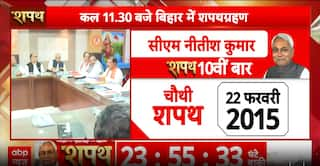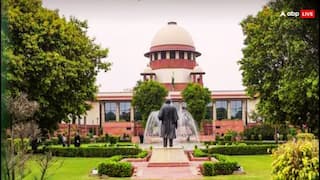Delhi-NCR: Air Quality Remains Poor With AQI At 266 Ahead Of Diwali
The Commission for Air Quality Management (CAQM) on Wednesday, said that Delhi-NCR's Air Quality Index (AQI) will likely be 300 plus on October 22.

New Delhi: The festival of Diwali will be celebrated on October 24, 2022, across India. As people of the country including Delhi are gearing up for the festival, the problem of air quality is also becoming a big concern. The overall Air Quality Index (AQI) in the national capital touched 266 on Saturday evening, as reported by the news agency ANI.
The Commission for Air Quality Management (CAQM) on Wednesday, said that Delhi-NCR's Air Quality Index (AQI) will likely be 300 plus on October 22.
Delhi's overall air quality is in the 'Poor' category with Air Quality Index at 266 today, as per SAFAR India air quality service https://t.co/scpQmG7Uzq
— ANI (@ANI) October 23, 2022
According to the System of Air Quality and Weather Forecasting and Research (SAFAR), the AQI index in the overall Delhi region was in the ‘Poor’ category’ at 266. The index was in the ‘very poor’ category in the Delhi University area at 327, ‘poor’ quality in Mathura Road at 293, and in the ‘moderate’ category in Gurugram at 156 on Saturday evening.
Transport-level winds from Punjab, Haryana, and Uttar Pradesh towards Delhi will pick up from October 24 and, in all likelihood, will bring significant stubble-related emissions to Delhi, SAFAR said, as reported by the news agency PTI.
“If stubble burning increases gradually, which is likely, its share in Delhi’s PM2.5 (based on the average temporal variability of fire counts in the previous years) is likely to be 5 per cent on the October 23, 8 per cent on October 24 and 16 to 18 per cent on October 25,” SAFAR’s predictions said, according to PTI.
“Adverse weather conditions may bring firecracker-related pollution from surrounding regions of Delhi (outside NCT) and with 15 to 18 per cent stubble burning contribution, the AQI is predicted to touch the upper end of ‘very poor’ to lower end of ‘severe’ on October 25 (without emission from firecrackers in Delhi),” the predictions said.
Emission From Firecrackers, Other Factors Could Worsen AQI To ‘Severe’ On Diwali
According to PTI, SAFAR also predicted that in case there was emission from firecrackers, along with other factors, the AQI would worsen to ‘severe’ on Diwali (October 23) and might continue to remain the same for the next two days (October 24 and October 25). “Air quality might improve slightly on October 26 evening onwards to the lower end of ‘very poor’ category as surface winds will pick up on October 26 and stubble transport level winds will slow down,” the predictions said.
Predicting the air quality to deteriorate by the weekend, the Commission for Air Quality Management (CAQM) had on Wednesday directed authorities to enact Stage II of the Graded Response Action Plan (GRAP) — a set of anti-air pollution measures followed in the national capital and its vicinity, according to the severity of the situation.
The Stage II plan includes banning the use of coal and firewood in hotels, restaurants, and open eateries. The use of diesel generators, except for essential services, is also banned. GRAP is classified under four stages, depending on the air quality in Delhi. Stage I is implemented in case of ‘poor’ air quality (AQI 201-300); Stage II for ‘very poor’ (AQI 301-400); Stage III for ‘severe’ (AQI 401-450) and Stage IV for ‘severe plus’ (AQI >450).
GRAP Stage III To Be Enforced If AQI Deteriorates Further
If the situation turns ‘severe’ (Stage III), authorities will have to enforce a ban on construction and demolition activities in NCR, except on essential projects (such as railways, metros, airports, ISBTs, national security/defence-related projects of national importance) and non-polluting activities such as plumbing, carpentry, interior decoration and electrical works.
Brick kilns, hot mix plants and stone crushers not operating on clean fuels and mining and associated activities in NCR will also be banned. The state governments in Delhi-NCR may also impose restrictions on Bharat Stage (BS)-III petrol and BS-IV diesel light motor vehicles (four-wheelers).
The measures in the ‘severe plus’ category or Stage IV include a ban on the entry of trucks into Delhi and on the plying of Delhi-registered diesel-run medium goods vehicles and heavy goods vehicles in the national capital, except those carrying essential commodities.
Four-wheeled diesel light motor vehicles, except BS-VI and those engaged in essential services, will also be banned in Delhi and bordering districts of NCR. Stage IV will also trigger a ban on industries running on dirty fuels and construction and demolition activities in linear public projects such as highways, roads, flyovers, over bridges, power transmission, and pipelines.
Earlier on Saturday, the images appeared of a blanket of smog in the morning which engulfed the national capital as the pollution level deteriorated the air quality to the ‘poor’ category. An AQI between zero and 50 is considered good, 51 and 100 satisfactory, 101 and 200 moderate, 201 and 300 poor, 301 and 400 very poor, and 401 and 500 severe.
The CAQM in its tweet said that air quality will move towards "Very Poor" and further actions under Stage I will be intensified. "All actions as envisaged under Stage II of the GRAP - 'Very POOR' Air Quality to be implemented in the right earnest and further actions under Stage I to be intensified by all the agencies concerned," read the tweet from CAQM.
(With Inputs from agencies)
Top Headlines







































